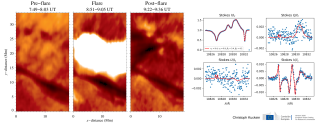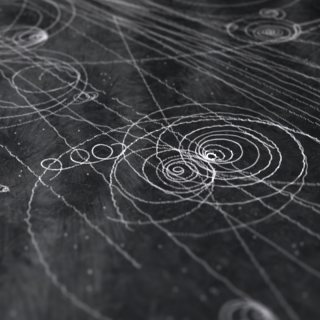Grants related:
General
Welcome to the Traces of Galaxy Formation research group website.
We are a large, diverse, and very active research group aiming to provide a comprehensive picture for the formation of galaxies in the Universe. Rooted in detailed stellar population analysis, we are constantly exploring and developing new tools and ideas to understand how galaxies came to be what we now observe.
A complex star formation history, as the one expected to describe galaxy evolution, needs a multidisciplinary approach to be fully understood. Our group at the IAC consists of experienced researchers in cosmological simulations, dynamical studies, stellar populations and morphological properties of galaxies up to high redshift. We combine different approaches (e.g. observations and theory, secular and cosmological evolution studies) to obtain a complete view of the dominant mechanisms driving the evolution of galaxies.
Within this general framework, we are currently exploring three main areas of research:
- Stellar population synthesis models
- Development of new stellar population synthesis models
- Stellar population analysis tools
- Universality of the stellar initial mass function (IMF)
- Cosmic evolution of galaxies
- Massive galaxy evolution
- Stellar populations in different environments
- Low surface brightness science
- Machine learning and cosmological simulations
- Evolutionary processes in nearby galaxies
- The role of black holes in the evolution of galaxies
- Surveys of nearby galaxies
- Stellar kinematics and dynamical models
If you want to get in contact or work with us, please send an email to the head of the group (Ignacio Martín-Navarro ignacio.martin [at] iac.es (ignacio[dot]martin[at]iac[dot]es)).
Members
Results
Here you can find some of our most recent highlights:
- Local variations of the stellar velocity ellipsoid - II. The effect of the bar in the inner regions of Auriga galaxies. Walo et al. 2022, MNRAS (https://ui.adsabs.harvard.edu/abs/2022MNRAS.513.4587W)
- Anisotropic satellite galaxy quenching modulated by black hole activity. Martín-Navarro et al. 2021, Nature (https://ui.adsabs.harvard.edu/abs/2021Natur.594..187M)
- Evaluating hydrodynamical simulations with green valley galaxies. Angthopo et al. 2021, MNRAS (https://ui.adsabs.harvard.edu/abs/2021MNRAS.502.3685A)
- Sub one per cent mass fractions of young stars in red massive galaxies. Salvador-Rusiñol et al. 2020, Nature Astronomy (https://ui.adsabs.harvard.edu/abs/2020NatAs...4..252S)
- Detection of young stellar populations in apparently quenched low-mass galaxies using red spectral line indices. de Lorenzo-Cáceres et al. 2020, MNRAS (https://ui.adsabs.harvard.edu/abs/2020MNRAS.498.1002D)
Scientific activity
Related publications
-
Rejuvenation triggers nuclear activity in nearby galaxies
Feedback, in particular from active galactic nuclei (AGNs), is believed to play a crucial role in the evolution of galaxies. In the local Universe, many galaxies with an AGN are indeed observed to reside in the so-called green valley, usually interpreted as a transition phase from a blue star-forming to a red quenched state. We use data from the
Martín-Navarro, Ignacio et al.Advertised on:
62022 -
Low-metallicity globular clusters in the low-mass isolated spiral galaxy NGC 2403
The globular cluster (GC) systems of low-mass late-type galaxies, such as NGC 2403, have been poorly studied to date. As a low mass galaxy (M * = 7 × 10 9 M ⊙), cosmological simulations predict NGC 2403 to contain few, if any, accreted GCs. It is also isolated, with a remarkably undisturbed HI disc. Based on candidates from the literature, Sloan
Forbes, Duncan A. et al.Advertised on:
52022 -
Strong CO absorption features in massive ETGs
Massive Early-Type Galaxies (ETGs) in the local Universe are believed to be the most mature stage of galaxy evolution. Their stellar population content reveals the evolutionary history of these galaxies. However, while state-of-the-art Stellar Population Synthesis (SPS) models provide an accurate description of observed galaxy spectra in the
Eftekhari, Elham et al.Advertised on:
52022 -
Inferring the helium abundance of extragalactic globular clusters using integrated spectra
The leading method for the determination of relevant stellar population parameters of unresolved extragalactic Globular Clusters is through the study of their integrated spectroscopy, where Balmer line-strength indices are considered to be age sensitive. Previously, a splitting in the highly optimized spectral line-strength index H β o was observed
Leath, H. J. et al.Advertised on:
52022 -
Implications for galaxy formation models from observations of globular clusters around ultradiffuse galaxies
We present an analysis of Hubble Space Telescope observations of globular clusters (GCs) in six ultradiffuse galaxies (UDGs) in the Coma cluster, a sample that represents UDGs with large effective radii (R e), and use the results to evaluate competing formation models. We eliminate two significant sources of systematic uncertainty in the
Saifollahi, Teymoor et al.Advertised on:
42022 -
The dark side of galaxy stellar populations - I. The stellar-to-halo mass relation and the velocity dispersion-halo mass relation
The growth and properties of galaxies are thought to be closely connected to the ones of their host dark matter haloes. Despite the importance of this so-called galaxy-halo connection, the potential role of dark matter haloes in regulating observed galaxy properties remains yet to be fully understood. In this work, we derive the ages, metallicites
Scholz-Díaz, Laura et al.Advertised on:
42022 -
CO-CAVITY pilot survey: Molecular gas and star formation in void galaxies
Context. Voids are the most under-dense large-scale regions in the Universe. Galaxies inhabiting voids are one of the keys for understanding the intrinsic processes of galaxy evolution, as external factors such as multiple galaxy mergers or a dense self-collapsing environment are negligible. Aims: We present the first molecular gas mass survey of
Domínguez-Gómez, J. et al.Advertised on:
22022 -
Observed versus simulated halo c-M<SUB>vir</SUB> relations
The concentration - virial mass relation is a well-defined trend that reflects the formation of structure in an expanding universe. Numerical simulations reveal a marked correlation that depends on the collapse time of dark matter haloes and their subsequent assembly history. However, observational constraints are mostly limited to the massive end
Leier, Dominik et al.Advertised on:
22022 -
From blue cloud to red sequence: evidence of morphological transition prior to star formation quenching
We present a study of a sample of 254 clusters from the SDSS-DR7 Yang Catalogue and an auxiliary sample of field galaxies to perform a detailed investigation on how galaxy quenching depends on both environment and galaxy stellar mass. Our samples are restricted to 0.03 ≤ z ≤ 0.1 and we only consider clusters with log (M halo/M ⊙) ≥ 14. Comparing
Sampaio, V. M. et al.Advertised on:
12022 -
The Fornax3D project: Planetary nebulae catalogue and independent distance measurements to Fornax cluster galaxies
Extragalactic planetary nebulae (PNe) offer a way to determine the distance to their host galaxies thanks to the nearly universal shape of the planetary nebulae luminosity function (PNLF). Accurate PNe distance measurements rely on obtaining well-sampled PNLFs and the number of observed PNe scales with the encompassed stellar mass. This means
Spriggs, T. W. et al.Advertised on:
92021 -
Capturing the Physics of MaNGA Galaxies with Self-supervised Machine Learning
As available data sets grow in size and complexity, advanced visualization tools enabling their exploration and analysis become more important. In modern astronomy, integral field spectroscopic galaxy surveys are a clear example of increasing high dimensionality and complex data sets, which challenges the traditional methods used to extract the
Sarmiento, Regina et al.Advertised on:
112021 -
Chronos: A NIR spectroscopic galaxy survey to probe the most fundamental stages of galaxy evolution
We propose a dedicated, ultra-deep spectroscopic survey in the near infrared (NIR), that will target a mass-limited sample of galaxies during two of the most fundamental epochs of cosmic evolution: the formation of the first galaxies (at z ≳ 6; cosmic dawn), and at the peak of galaxy formation activity (at redshift z∼1-3; cosmic noon). By way of
Ferreras, I. et al.Advertised on:
62021 -
Physically Motivated Fit to Mass Surface Density Profiles Observed in Galaxies
Polytropes have gained renewed interest because they account for several seemingly disconnected observational properties of galaxies. Here we study whether polytropes are also able to explain the stellar mass distribution within galaxies. We develop a code to fit surface density profiles using polytropes projected in the plane of the sky (propols)
Sánchez Almeida, Jorge et al.Advertised on:
112021 -
Rejuvenation triggers nuclear activity in nearby galaxies
Feedback, in particular from active galactic nuclei (AGN), is believed to play a crucial role in the evolution of galaxies. In the local Universe, many galaxies with an AGN are indeed observed to reside in the so-called green valley, usually interpreted as a transition phase from a blue star-forming to a red quenched state. We use data from the
Advertised on:
102021Bibcode -
Outflows from starburst galaxies with various driving mechanisms and their X-ray properties
Outflows in starburst galaxies driven by thermal-mechanical energy, cosmic rays, and their mix are investigated with 1D and 2D hydrodynamic simulations. We show that these outflows could reach a stationary state, after which their hydrodynamic profiles asymptotically approach previous results obtained semi-analytically for stationary outflow
Yu, B. P. Brian et al.Advertised on:
122021 -
X-ray bubbles in the circumgalactic medium of TNG50 Milky Way- and M31-like galaxies: signposts of supermassive black hole activity
The TNG50 cosmological simulation produces X-ray emitting bubbles, shells, and cavities in the circumgalactic gas above and below the stellar discs of Milky Way- and Andromeda-like galaxies with morphological features reminiscent of the eROSITA and Fermi bubbles in the Galaxy. Two-thirds of the 198 MW/M31 analogues inspected in TNG50 at z = 0 show
Pillepich, Annalisa et al.Advertised on:
122021 -
Anomaly detection in Hyper Suprime-Cam galaxy images with generative adversarial networks
The problem of anomaly detection in astronomical surveys is becoming increasingly important as data sets grow in size. We present the results of an unsupervised anomaly detection method using a Wasserstein generative adversarial network (WGAN) on nearly one million optical galaxy images in the Hyper Suprime-Cam (HSC) survey. The WGAN learns to
Storey-Fisher, Kate et al.Advertised on:
122021 -
NGC 5746: Formation history of a massive disc-dominated galaxy
The existence of massive galaxies lacking a classical bulge has often been proposed as a challenge to ΛCDM. However, recent simulations propose that a fraction of massive disc galaxies might have had very quiescent merger histories, and also that mergers do not necessarily build classical bulges. We test these ideas with deep MUSE observations of
Martig, Marie et al.Advertised on:
122021 -
Fornax 3D project: Assessing the diversity of IMF and stellar population maps within the Fornax Cluster
The stellar initial mass function (IMF) is central to our interpretation of astronomical observables and to our understanding of most baryonic processes within galaxies. The universality of the IMF, suggested by observations in our own Milky Way, has been thoroughly revisited due to the apparent excess of low-mass stars in the central regions of
Martín-Navarro, I. et al.Advertised on:
102021 -
Introducing the LBT Imaging of Galactic Halos and Tidal Structures (LIGHTS) survey. A preview of the low surface brightness Universe to be unveiled by LSST
We present the first results of the LBT Imaging of Galaxy Haloes and Tidal Structures (LIGHTS) survey. LIGHTS is an ongoing observational campaign with the 2 × 8.4 m Large Binocular Telescope (LBT) aiming to explore the stellar haloes and the low surface brightness population of satellites down to a depth of μ V ∼ 31 mag arcsec −2 (3σ in 10″ × 10″
Trujillo, Ignacio et al.Advertised on:
102021



